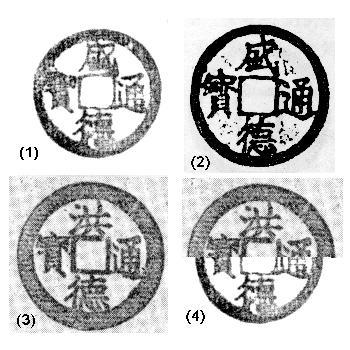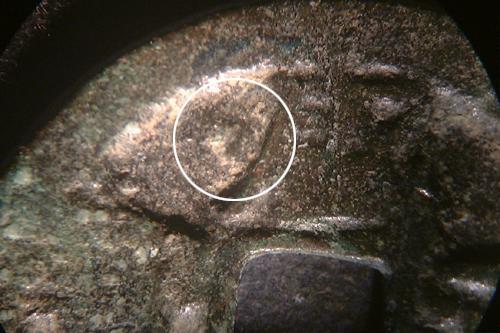 The
later
Le dynasty was founded by Le Loi in 1428 and was the
last of the great Vietnamese dynasties. It retained unified power over
the kingdom until 1527 when the throne was usurped by Dang Dung
of the Mac family. The
Mac dynasty was established in 1527
but control of the country would become divided between three powerful
families, the Mac, Trinh, and
Nguyen. The
Le
remained on the throne as puppets supported by the Trinh family
and issued some currency after 1527. The Mac dynasty also issued
official currency until about 1573. The
later
Le dynasty was founded by Le Loi in 1428 and was the
last of the great Vietnamese dynasties. It retained unified power over
the kingdom until 1527 when the throne was usurped by Dang Dung
of the Mac family. The
Mac dynasty was established in 1527
but control of the country would become divided between three powerful
families, the Mac, Trinh, and
Nguyen. The
Le
remained on the throne as puppets supported by the Trinh family
and issued some currency after 1527. The Mac dynasty also issued
official currency until about 1573.
There are few recorded coins belonging to the later Le family from the period of about 1578 to 1658. Just before this period Le The Tong issued a coin with the inscription of Gia Thai Thong Bao during the reign of Gia Thai (1573-1577). Just after this period coins were again issued by Le Than Tong during his third reign of Vinh Tho (1658-1661), and were issued in great quantity. However there are few if any coins that can be assigned to Le Than Tong's second reign of Thinh Duc , from 1653 to 1656. The figures right show four images of rubbings. Figure 1 shows a rubbing of the Thinh Duc piece under study. Figure 2 shows a rubbing of a different Thinh Duc which is listed in the Vietnamese coin section of Ding Fu Bao Catalog. The same rubbing of the same piece was borrowed from Ding Fu Bao and is listed in "Illustrated plates of Ancient Chinese Coins". Both works list the coin in the unassigned Vietnamese coin section and neither assign it to the reign of Thinh Duc. The piece in figure 1 under study would appear to be a contemporary fake made by taking a common coin from the much earlier reign of Hong Duc (1470-1476), altering the top character and then recasting the altered piece to make the forgery. Evidence for this comes from a comparison of the bottom three characters of figure 1 with the same characters of a coin from the reign of Hong Duc, illustrated in figure 3. The shape and calligraphy of all three characters are exactly the same which is virtually impossible for two coins made almost 200 years apart. Some of the most obvious features that are the same include the unusually large triangular head of the character 'Thong', the left hand vertical stroke and dot of the 'Thong', and the very unequal size of the feet of the 'Bao'. Further evidence for the recasting comes from the size of the coin in figure 1. When a coin is cast from a master pattern, the master is used to make an impression in a material like sand or clay to make a mould. This mould is then filled with hot liquid bronze which cools and solidifies. The bronze solidifies at about 900 degrees C and will then shrink a characteristic 5% before fully cooling. Figure 4 is a composite image of the rubbings in figures 1 and 3 where it can be seen that the coin in figure 1 is approximately 5% smaller then the one in figure 3. In figure 4 the inner rims of the two pieces have been aligned on the left-hand side and the shrinkage can easily be seen by the misalignment of the rim on the right-hand side. A comparison of the inner rim must be made because the size of the outer rim may change because of wear or filing during manufacture.
A final point must be made about the patina because if
the coin is a recent forgery the patina must be artificial. Although the
patina is appealing, particularly on the back of the coin, a comparison
between the coin in figure 1 and three other confirmed recent forgeries
suggest that the patina is indeed fake. These two of these three other
forgeries are also Vietnamese coins and one was made by the same process
of changing the top character. It is quite possible that more than one
of these fakes were made by the same forger.
Allan Barker
|
 The
final conclusive evidence for the recasting is shown in the microscopic
view the top character in figure 5. When the top character was removed
from the original Hong Duc coin a little bit of residual metal was
left from the character 'Hong'. One of the most prominent differences
between the character 'Hong' and 'Thinh' are the two short
strokes on the left-hand side of the character 'Hong'. Residual
metal from the larger of these two strokes can be seen in the middle of
the circle in figure 5. Similar but less obvious features can be seen at
other places along the edge of the character 'Thinh', but are not
seen near any of the other three characters.
The
final conclusive evidence for the recasting is shown in the microscopic
view the top character in figure 5. When the top character was removed
from the original Hong Duc coin a little bit of residual metal was
left from the character 'Hong'. One of the most prominent differences
between the character 'Hong' and 'Thinh' are the two short
strokes on the left-hand side of the character 'Hong'. Residual
metal from the larger of these two strokes can be seen in the middle of
the circle in figure 5. Similar but less obvious features can be seen at
other places along the edge of the character 'Thinh', but are not
seen near any of the other three characters.